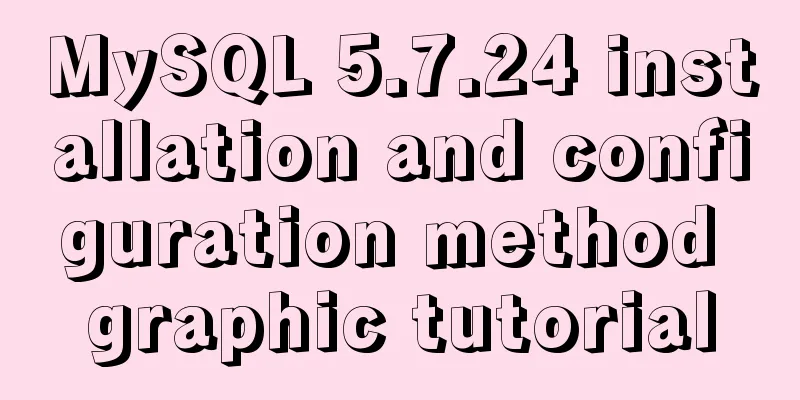MySQL 5.7.24 installation and configuration method graphic tutorial

|
MySQL is the most popular relational database management system. In terms of WEB applications, MySQL is one of the best RDBMS (Relational Database Management System) application software. 1. Download the MySQL installation package Open the website to download MySQL (MySQL download address link) The default link to this website is the latest version of MySQL, so if you need to download version 5.7, you need to click the link in the picture below to download it.
Select the version that corresponds to your computer, which is generally a 64-bit computer.
Next, click Download and select No thanks, just start my download to download the installation package directly. 2. Unzip to the corresponding folder The downloaded file is a compressed file, unzip it to the directory you want to put it in.
Configure MySQL environment variables, system variables--->New---->Variable name MYSQL_HOME, variable value is your path name My variable name is: C:\MySQL\mysql-5.7.24-winx64 Then change the Path environment variable and add the following value: %MYSQL_HOME%\bin 3. my.ini file There is no data folder and my.ini file in the folder you unzipped, so add an empty data folder and a my.ini file. The contents of the my.ini file are as follows [mysql] # Set the default character set of the mysql client to default-character-set=utf8 [mysqld] #Set port 3306 port = 3306 # Set the installation directory of mysql to basedir=C:\MySQL\mysql-5.7.24-winx64 # Set the storage directory of MySQL database data datadir=C:\MySQL\mysql-5.7.24-winx64\data # Maximum number of connections allowed max_connections=200 # The default character set used by the server is the 8-bit latin1 character set character-set-server=utf8 # The default storage engine that will be used when creating a new table default-storage-engine=INNODB
4. Install MySQL service and initialize Run cmd as an administrator and execute the command to install the mysql service: mysqld install We can see that the service has been successfully installed. If the installation fails, it may be because you installed it before but did not uninstall it completely, so be sure to uninstall it completely.
Then execute the mysql initialization command: msqld --initialize
Execute this command and start our mysql: net start mysql
The following errors may occur here
The solution is to enter our MySQL decompression package, delete the data folder, and then re-execute the command: mysqld --initialize Execute: net start mysql and you will find that the service is started successfully. After successful startup, we log in. Since there is a default password during initialization, where can we find the default password? In the file ending with err under our data folder.
Execute the command: mysql -u root -p Enter the password found above: EcpHl,h33/N), then log in and change the default root password: alter user root@localhost identified by '123456'; Finally, let’s talk about how to set the username and password for remote connection: We use Navicat for user management. When adding a new user, you can see the host input box. When setting it up, if you want the user to be able to connect remotely, please enter %. If it is for local connection, please enter localhost
Wonderful topic sharing: MySQL different versions installation tutorial MySQL 5.6 installation tutorials for various versions MySQL 5.7 installation tutorials for various versions mysql8.0 installation tutorials for various versions The above is the full content of this article. I hope it will be helpful for everyone’s study. I also hope that everyone will support 123WORDPRESS.COM. You may also be interested in:
|
<<: Nginx uses reverse proxy to implement load balancing process analysis
>>: In-depth explanation of modes and environment variables in Vue CLI
Recommend
Pure HTML and CSS to achieve JD carousel effect
The JD carousel was implemented using pure HTML a...
Understanding and application analysis of mysql pessimistic locking and optimistic locking
This article uses examples to describe MySQL pess...
JavaScript using Ckeditor + Ckfinder file upload case detailed explanation
Table of contents 1. Preparation 2. Decompression...
Implementing the page turning effect through sliding and the click event problem on the mobile terminal
aforementioned This article is very short~ The ma...
Example code for implementing image adaptive container with CSS
There is often a scenario where the image needs t...
HTML symbol to entity algorithm challenge
challenge: Converts the characters &, <, &...
A brief discussion on HTML ordered lists, unordered lists and definition lists
Ordered List XML/HTML CodeCopy content to clipboa...
Learn one minute a day to use Git server to view debug branches and fix them
Debug branch During the normal development of a p...
Detailed discussion of several methods for deduplicating JavaScript arrays
Table of contents 1. Set Deduplication 2. Double ...
Docker+K8S cluster environment construction and distributed application deployment
1. Install Docker yum install docker #Start the s...
MySQL index cardinality concept and usage examples
This article uses examples to explain the concept...
Setting up shadowsocks+polipo global proxy in Linux environment
1. Install shadowsocks sudo apt-get install pytho...
MySQL MyISAM default storage engine implementation principle
By default, the MyISAM table will generate three ...
Several ways to implement image adaptive container with CSS (summary)
There is often a scenario where the image needs t...
Detailed explanation of the execution order of JavaScript Alert function
Table of contents question analyze solve Replace ...




















